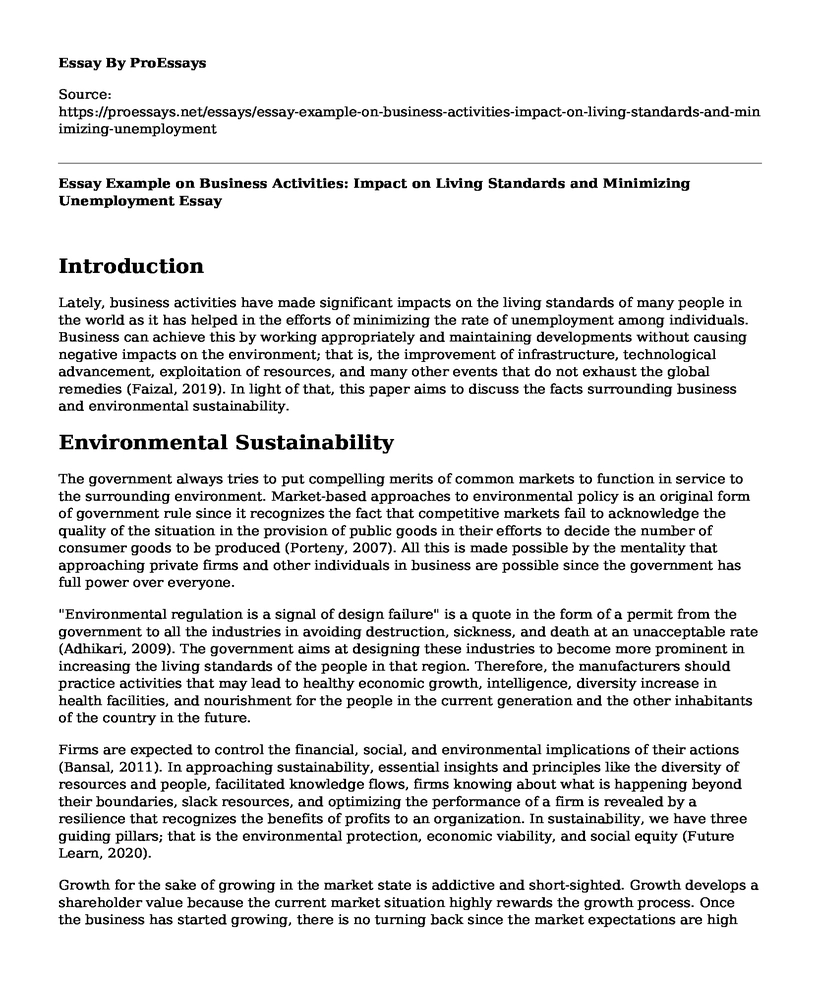Introduction
Lately, business activities have made significant impacts on the living standards of many people in the world as it has helped in the efforts of minimizing the rate of unemployment among individuals. Business can achieve this by working appropriately and maintaining developments without causing negative impacts on the environment; that is, the improvement of infrastructure, technological advancement, exploitation of resources, and many other events that do not exhaust the global remedies (Faizal, 2019). In light of that, this paper aims to discuss the facts surrounding business and environmental sustainability.
Environmental Sustainability
The government always tries to put compelling merits of common markets to function in service to the surrounding environment. Market-based approaches to environmental policy is an original form of government rule since it recognizes the fact that competitive markets fail to acknowledge the quality of the situation in the provision of public goods in their efforts to decide the number of consumer goods to be produced (Porteny, 2007). All this is made possible by the mentality that approaching private firms and other individuals in business are possible since the government has full power over everyone.
"Environmental regulation is a signal of design failure" is a quote in the form of a permit from the government to all the industries in avoiding destruction, sickness, and death at an unacceptable rate (Adhikari, 2009). The government aims at designing these industries to become more prominent in increasing the living standards of the people in that region. Therefore, the manufacturers should practice activities that may lead to healthy economic growth, intelligence, diversity increase in health facilities, and nourishment for the people in the current generation and the other inhabitants of the country in the future.
Firms are expected to control the financial, social, and environmental implications of their actions (Bansal, 2011). In approaching sustainability, essential insights and principles like the diversity of resources and people, facilitated knowledge flows, firms knowing about what is happening beyond their boundaries, slack resources, and optimizing the performance of a firm is revealed by a resilience that recognizes the benefits of profits to an organization. In sustainability, we have three guiding pillars; that is the environmental protection, economic viability, and social equity (Future Learn, 2020).
Growth for the sake of growing in the market state is addictive and short-sighted. Growth develops a shareholder value because the current market situation highly rewards the growth process. Once the business has started growing, there is no turning back since the market expectations are high and may cause hammering of the price shares (Larson, 2008). The fact of growth creates a new mentality among individuals on strategic thinking on the methods of preventing retardation in development; therefore, there will be more developments around the business environments creating better living conditions for the individuals.
Conclusion
Indeed, the comprehensive facts surrounding business and its environments are thoroughly discussed. The government ensures that the stock market is advantageous to the current environment. It realizes that competitive firms fail to provide public resources to the public. Better environments are handed as a responsibility to the government since they are supposed to control the manufacturers from increasing death rates by polluting the environment. There are three pillars of sustainability; that is, social equity, economic viability, and environmental protection. The growth of a business is like a virus since it is addictive and short-sighted. The continuous growth of the market causes fast developments in the environment.
References
Adhikari, A. W.-B. (2009). Market-based approaches to environmental problems. Econstor, 4-32.
Bansal, T. (2011, December 19). 5 Principles of a Sustainable Business Model. Retrieved from Network for business sustainability: https://www.nbs.net/articles/five-principles-of-a-sustainable-business-model
Faizal, F. (2019, July 21). Environmental Sustainability In Business. Retrieved from Feedough.com: https://www.feedough.com/environmental-sustainability-in-business/
Future Learn. (2020, April 29). The three pillars of sustainability. Retrieved from futurelearn.com: https://www.futurelearn.com/courses/sustainability-society-and-you/0/steps/4618
Larson, M. (2008, October). Growth for Growth's Sake: A Recipe for a Potential Disaster. Retrieved from Ivey Business Journal: https://iveybusinessjournal.com/publication/growth-for-growths-sake-a-recipe-for-a-potential-disaster/
Porteny, P. (2007). Market-Based Approaches to Environmental Policy: A "Refresher" Course. Research Gate, 15-18.
Cite this page
Essay Example on Business Activities: Impact on Living Standards and Minimizing Unemployment. (2023, Aug 08). Retrieved from https://proessays.net/essays/essay-example-on-business-activities-impact-on-living-standards-and-minimizing-unemployment
If you are the original author of this essay and no longer wish to have it published on the ProEssays website, please click below to request its removal:
- The Rise of Internet Giants - Essay Sample
- Fitbit VRIO Analysis Paper Example
- Nursing Shortage: Presenting the Problem Paper Example
- The Overselling of Globalization Article Review Paper Example
- HR Planning: Optimizing Employee Performance & Satisfaction - Essay Sample
- Senegal: Africa's Economic Giant With 6% GDP Growth - Research Paper
- Sustainable Business Advisory - Report Example







